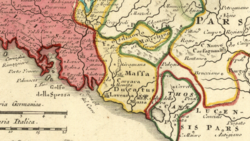This article needs additional citations for verification .(January 2023) |
You can help expand this article with text translated from the corresponding article in Spanish. Click [show] for important translation instructions.
|
Marquisate of Fosdinovo | |||||||||||
|---|---|---|---|---|---|---|---|---|---|---|---|
| 1355–1797 | |||||||||||
Shield of the Malaspina family | |||||||||||
| Motto: Sum mala spina bonis (Latin for 'I am a good thorn in the bad') | |||||||||||
 Fosdinovo (yellow, north of Massa and Carrara). | |||||||||||
| Status | Marquess, Fief | ||||||||||
| Capital | Fosdinovo | ||||||||||
| Common languages | Italian | ||||||||||
| Demonym(s) | Malaspinans | ||||||||||
| Government | Monarchy | ||||||||||
| Marquess | |||||||||||
• 1355– c. 1393 (first) | Galeotto I | ||||||||||
• 1759–1797 (last) | Carlo Emanuele | ||||||||||
| History | |||||||||||
• Conquered by the Malaspinas | 1355 | ||||||||||
• Annexation to the Cisalpine Republic | 1797 | ||||||||||
| Currency | Liguino | ||||||||||
| |||||||||||
| Today part of | Italy | ||||||||||
The Marquisate of Fosdinovo was a small fiefdom, led by a Marquess, that existed in the Italian peninsula between 1355 and 1797. It was based around Fosdinovo, a city east of La Spezia, and was ruled by the Malaspinas, a prominent Italian family, throughout its existence.
Contents



